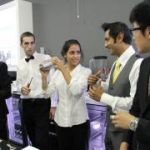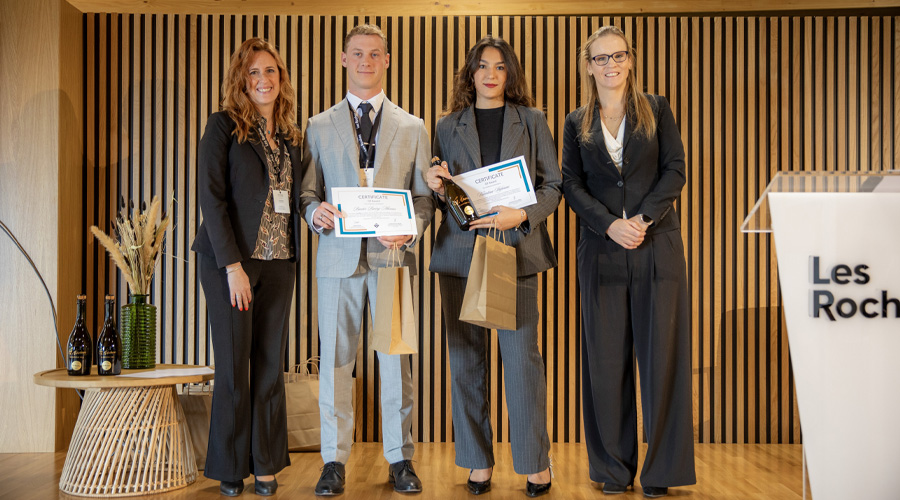A group of 17 Les Roches students of the MBA and the MS in Hospitality Leadership programs visited Kyoto, Japan on 28 March to 1 April to learn about Omotenashi, the Japanese concept of hospitality. There are different interpretations of Omotenashi but all share the same underlying principles of offering immaculate, genuine, and heart-felt service and treating people with the utmost respect, care and attention.
We experienced the meaning of Omotenashi first-hand and how it can be transferred into our future careers in the hospitality industry.
Cultural Immersion Activities
Our field trip followed a tight itinerary and every day was packed with enriching activities that added value to our hospitality careers and cultural experiences:
Tea ceremony
We studied Chado at the Urasenke Chado School, which is currently owned by the 60th (!) generation of the Soshitsu family. Chado is the way of tea and its origin defined the Japanese style of hospitality, Omotenashi. Tea ceremonies are the “spiritual and aesthetic discipline built around the preparation and serving of matcha tea.”

Ikebana (Flower Arrangement)
In Japan, there is so much more than meets the eye. Every movement is intentional and deeply rooted in tradition and meaning. (driventheatre.com) Ikebana is the disciplined art form in which nature and humanity are brought together and expressed through the arrangement of flowers. Elements of the sky, earth and humans are incorporated to create balance and harmony.

Incense practice
The Shoyeido Company produces incense, small sticks that release different aromas when burned. While this visit was not directly linked to Omotenashi, the underlying principles are still similar and it was an interesting way to learn about Japanese culture. We discovered the different scents, learned to recognize smells, and about the philosophy behind their creation.
Ryokan visit
The Hiiragiya is the most famous and oldest Ryokan (Japanese inn) in Kyoto and is family-owned in the 6th generation. The owners arranged a seminar about Ryokan hotels and gave us a tour of their guest rooms. We gained some valuable insights into their business and service model.

Professional Meetings
During the trip, we were very fortunate to meet with the General Managers of Four Seasons, Ritz-Carlton and Hyatt in Kyoto to discuss their understanding of Omotenashi and how they implement Japanese hospitality at their properties. We had very open discussions that encouraged interaction between us and the GM’s with their respective teams.

We also met with the Ryokan Association and six Ryokan managers with the aim to help them address the challenges facing their industry: Japan’s decreasing population and the survival of Ryokans.
On our last night, we attended a dinner that hosted the executive members of the Ryokan Association, the Mayor of Kyoto, the Director of Japan’s Tourism Board, Directors of the International Convention Bureau and more of Kyoto’s industry leaders.
Temple Visits
Kyoto is renowned for its many temple structures and we visited Nanzen-Ji, one of the “five great Zen temples of Kyoto” with many notable structures and shrines to see.

Arashiyama is a district on the western outskirts of Kyoto where we visited the Tenryu-Ji temple and Bamboo Grove.

It was the perfect time to visit Kyoto during Sakura, the traditional cherry blossom season with the city lined with pink blooming trees.

Takeaways from the Trip
• Extremely valuable and memorable trip that increased the depth of our knowledge of hospitality.
• Omotenashi takes service to a level that is rarely seen in Western society. There is much to be learned from this.
• Rare opportunities to meet with GM’s and important hospitality figures in Kyoto to gain their insights and network with them.
Or in the words of my classmate Bryan Camps: “The experience of Omotenashi has forever changed my view on hospitality. Witnessing generations of individuals who dedicate their life to Omotenashi without expecting anything in return has truly changed me. Japanese culture will forever be instilled in my memory, and these practices will form a basis for my managing culture.”
Sunny Yang
Les Roches MBA student































